Jun
20
2009
 or Systematic and Biblical Theologies
or Systematic and Biblical Theologies
More on typology. A helpful picture.
Tim Challies summarises Gage and Barber’s approach in their study guide on Genesis 37-50:
“I have learned to expect to be underwhelmed with study guides. Sadly, it was with this expectation that I began to read The Story of Joseph and Judah, a guide written by Warren Gage, Associate Professor of Old Testament at Knox Theological Seminary and Christopher Barber, a lawyer who is also a graduate of Knox Theological Seminary. I am glad to say that this guide, which promises to provide a ‘fresh look at Genesis 37-50,’ does just that and does it very well.
Continue reading
Comments Off | tags: Joseph, Judah, Tim Challies, Typology, Warren Gage | posted in Biblical Theology, Quotes
Jun
20
2009
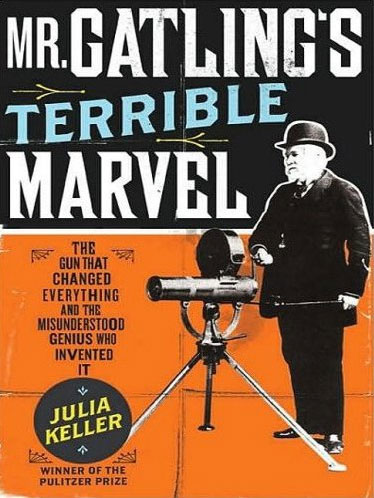
or Typology: Deadly Weapon or game of Scattergories?
“Chiastic literary analysis has completely destroyed liberal literary criticism. Liberalism is in tatters, bleeding and dying. Liberalism cannot survive Dorsey’s chiastic proof of the total unity of Isaiah, for instance. Dorsey finds loads of 7-fold chiasms in the Bible. I’ve found scores more, quite independently. What Dorsey does not see is that these are recaps of the chiasm of the 7 days in Genesis 1. And that’s good, because it means he did not go through the Bible forcing passages into heptamerous chiasms. He just found them there, and others can see that these track Genesis 1 as ‘new creation’ passages.”
—James B. Jordan, A Reply on the Nature of the Psalter, Biblical Horizons blog, biblicalhorizons.wordpress.com, referring to David A. Dorsey, The Literary Structure of the Old Testament.
If chiastic literary analysis (along with typology as I posted recently) is such a powerful weapon against a modernist interpretation of the Bible, why are these methods of study shunned by those who oppose liberal theology? Why are theologians hauled over the coals for using it if it leaves the enemy in shreds?
Continue reading
4 comments | tags: David A. Dorsey, David Field, Liberal theology, Peter Leithart, Systematic typology, Typology, Warren Gage | posted in Apologetics, Biblical Theology, Totus Christus
Jun
16
2009
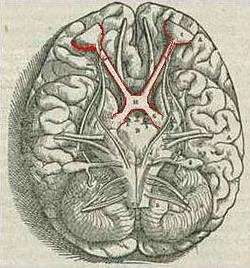
This is the intro to one JBA’s Amazon booklist. Too good a quote to pass up:
“In recent years postliberal theology and certain strands of Reformed thought have seen typology and chiasm as an essential method of biblical study.
While some forms of postmodernity are helpful to the church, most are not as avant garde as they pretend.
Ironically, liberals and most conservatives have the same method of bible study: you the individual must learn as many facts about the text as possible, importing back into the text foreign paradigms (or more accurately, bad foreign paradigms).
Typology, however, provides a subtle but deadly maneuver against modernity: it challenges modernity’s use of reason and forces it to think in terms of story and symbol, which by definition it can’t do.”
Yes, conservatives, he means you.
(Pic: the optic chiasma)
Comments Off | tags: Chiasm, Modernism, Typology | posted in Biblical Theology, Quotes
May
14
2009
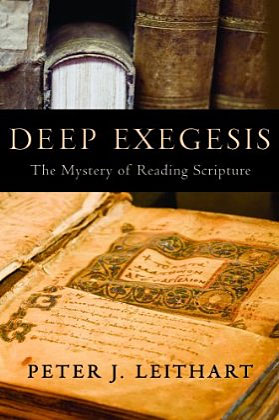
I was told once, after using a symbolic illustration from the Tabernacle while I was song-leading, that “we don’t want to head in that direction.” Basically, modern evangelicalism is not really all that interested in the Bible. The Tabernacle actually structures the New Testament at many levels, but modern Christians are classified as too dumb to cope with it. How many popular theologians ever deal with this stuff? This material IS the Bible.
Peter Leithart has been hauled over the coals for his use of typology in his commentary on Kings. But this is practically the same attitude the Jews have, when they accuse ALL Christians of eisegesis for seeing Christ in all the Scriptures.
Dr Leithart has a new book you can pre-order here, defending, I assume, his method. Those who question the validity of a sound use of typology would benefit from seeing how the Bible itself provides a safe framework for it.
I don’t know what examples Dr Leithart will give, but one that comes to mind is related to literary structure. When a passage of Scripture obviously recapitulates the structure and symbols of the Creation Week (as the one in my previous post did), is it eisegesis to draw from the passage interpretations related to this observation that are not actually written in the text? The Jews actually have it all over us on that one!
I do fear that Dr Leithart’s book might be an attempt to explain the how-to of flying like an eagle to a flock of emus. To use another analogy, the Bible is like a rainbow coloured balloon they are too afraid to actually inflate.
Comments Off | tags: Peter Leithart, Typology | posted in Biblical Theology
May
14
2009
Why do we put one-eyed, colour-blind pencil pushers in charge of the kaleidoscope?
The white stone mentioned in Revelation 2:17 was always a mystery to me. There are plenty of commentators who make lame suggestions as to its meaning (they sound a bit like a student making up answers during an exam!), but James Jordan got me thinking about it along the lines of its subtle use in the Old Testament. I intend to cover this in a few posts, and consequently may ramble even a little more than usual, but everything is connected in the Bible’s symbol language. This is a bit of a journey, but I am sure we will find it rewarding. Oh, and you will need to switch off your modernistic mind and use your imagination. You know, that thing you only use when you read or watch fiction? You can use it to understand the Bible as well. I know, scholars most often don’t. To cover their inability to make much sense of texts such as the one we are about to inhale, they pretend the writings are a bit primitive. Why do we put one-eyed, colour-blind pencil pushers in charge of the kaleidoscope?
Continue reading
7 comments | tags: High Priest, James Jordan, Modernism, Satan, Tabernacle, Typology, White stone, Zechariah | posted in Biblical Theology, The Restoration Era
Apr
24
2009
“The earth shall soon dissolve like snow,
The sun forbear to shine;
But God, who call’d me here below,
Will be forever mine.”
This verse in John Newton’s otherwise wonderful Amazing Grace makes me cringe. Bible symbolism is incredibly diverse, but also incredibly consistent, as a word search for flood or snow will show.
A flood is the rising of the Abyss in judgment, and after the historical flood, it was used by the prophets to picture Gentile nations flooding in from the ‘outer courts’ boundary over the four-cornered ‘Altar’ of Israel to wipe out the unfaithful ‘sons of God.’ It is used to picture Egypt, Babylon, and even the false teachings of the Judaisers in Revelation 12, but never mercy.
Snow only gets one negative rap, and that is the whiteness of ‘leprosy’ (actually, plague). In this case, it is the evil twin of true glory. It is death masquerading as life, an un-covering instead of a glorious robe.
“Woe to you, scribes and Pharisees, hypocrites! for you are like whited sepulchres, which indeed appear beautiful outward, but within are full of dead [men's] bones, and of all uncleanness.”
The symbols are important, and we are mostly illiterate concerning them. They are not poetic fluff in any way. God communicates truth by His word to interpret His creation. But we think like Greeks instead of Hebrews.
Comments Off | tags: John Newton, Typology | posted in Biblical Theology, Quotes
Apr
16
2009
What about the Grammatical Historical Method?
“I affirm and use the grammatical historical method in all my study of Scriptures, but I do not think it is the only method to use in our study or sermon preparation. If the Bible is one history with many sub-histories, then the grammatical historical method focuses too much on the subs and little on the one history. It draws our attention to the locus without seeing the larger picture. It focuses on the tree while missing the forest. Typology, on the other hand, working with GHM, gives validity to the Biblical language and the Biblical worldview.”
Uri Brito, http://apologus.wordpress.com
Comments Off | tags: Hermeneutics, Typology, Uri Brito | posted in Quotes
Apr
14
2009
or The Resurrection of Christ: Get Over It.
 The resurrection of Christ is the linchpin upon which all of Christianity depends. It is the point of the spear when it comes to evangelism.
The resurrection of Christ is the linchpin upon which all of Christianity depends. It is the point of the spear when it comes to evangelism.
But when the best theologians spend much of their time philosophising about its basic implications, their thinking divorced from most of the Bible, and relying instead upon Jewish fables and other ancient writings to form their opinions, we have a problem. When the cream of the crop are gagging on the milk, we have a problem.
Continue reading
Comments Off | tags: Hermeneutics, James Jordan, Paul, Resurrection, Typology, Uri Brito | posted in Biblical Theology
Apr
12
2009
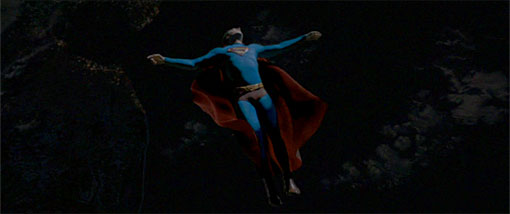
The movie Superman Returns ends with some powerful iconography. Lex Luther has used a crystal stolen from Superman to create his own ‘new earth.’ Unlike Superman’s white-as-snow fortress of solitude, this is made of dark stone, Adamic earth. It rises up out of the sea and its growth threatens mankind.
Superman carries the weight of the entire sinful rock, and its growing kryptonite ‘spears’ pierce him. He ‘dies’ in the air and his fall to earth creates a ‘tomb.’ It’s worth a watch.
My point is, the idea of Christ being ‘lifted up’ is more than the bronze serpent, more than us ‘lifting Him up’ in our witness. [1]
Lifted up between heaven and earth, He was an open scroll. The bloodied lid of the Ark, the Word engraved (opened) on tablets of flesh. [2] In the sky, He was a new kapporet [3], a firmament covering to replace the old one that was ready to vanish away. He was a veil that was open, still protecting yet providing full access.
The Old Testament is full of mediators who are ‘lifted up.’ Revelation shows the Satanic new earth (Herod and Rome) thrown down from her mediatory position ‘in the air’, and the saints ascending to meet their Lord ‘in the air’ as a new mediatorial city.
a) Christ was lifted up.
b) Satan was thrown down.
a1) The saints of the New Jerusalem ascended.
b1) The compromised mediators were thrown down.
Satan is no longer the prince of the powers of the air.
__________________
[1] A Herod also fulfilled the bronze serpent image, eaten alive by maggots on his throne ‘in the air’ after speaking ‘like a god.’ He prefigured the dirty scavenging birds feasting on the harlot in Revelation.
[2] The Tabernacle layout is a symbolic cruciform man. Notice that Christ on the cross was beneath ‘the Name’, an open scroll containing the disputed truth of His identity. The Lord’s Name was said to dwell above the lid of the Ark.
[3] See Peter Leithart, The Footstool of His Feet.
Comments Off | tags: Add new tag, Ark of the Covenant, Covenant curse, Crucifixion, Film, Herod, Peter Leithart, Preterism, Tabernacle, Typology | posted in Biblical Theology, The Last Days
Apr
11
2009
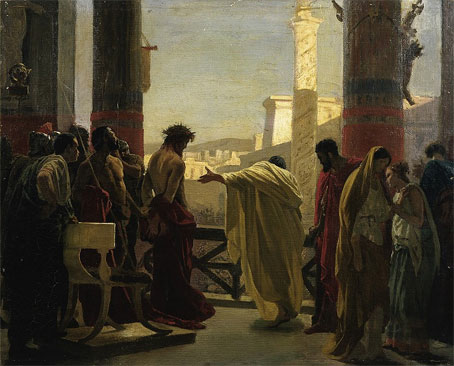
The Jews choose a violent, thieving murderer—like Herod—a beast, for release instead of the Son of God. When forced to choose, they publicly proclaim Caesar (Daniel’s fourth beast) as their king. When Adam is unjust, Eve follows the “light” of a beast.
Like Joseph and Daniel, the obedience of the suffering servant brings a nightmare to the Gentile ruler, or in this case, his wife. She warns Pilate to have nothing to do with “that just man”. From the seat of judgment, he gives the Jews a choice. Like Joseph and Daniel, the Jews unwittingly open the mystery of God.
Jesus is crowned with thorns as Adam’s successor. As Israel, He is a cursed Land bearing a cursed crop—the crown of Abimelech, the bramble king who slays his brothers. Christ dies on behalf of Herod’s kingdom, a compromised rule whose only use was kindling in God’s nostrils.
As High Priest making atonement on the mountain of God, Jesus is again flanked by two men. One ascends to paradise. The other goes to destruction.
Comments Off | tags: Abimelech, Atonement, Crucifixion, Daniel, Joseph, Judges, Pilate, Typology | posted in Biblical Theology
 or Systematic and Biblical Theologies
or Systematic and Biblical Theologies






























